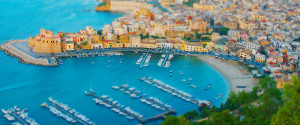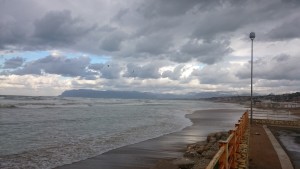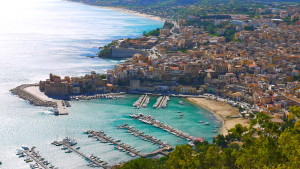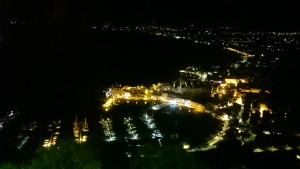 Castellammare del Golfo, according to the almost unanimous opinion of historians and geographers, was born as Emporium of Egesta (today Segesta). The site where the Elimi – population descended from the Trojans, who settled on the shores of the river Crimiso (now the St. Bartholomew), having obtained by Sicans part of their territory – exercised their trade with foreign ships.
Castellammare del Golfo, according to the almost unanimous opinion of historians and geographers, was born as Emporium of Egesta (today Segesta). The site where the Elimi – population descended from the Trojans, who settled on the shores of the river Crimiso (now the St. Bartholomew), having obtained by Sicans part of their territory – exercised their trade with foreign ships.
In 416 BC Egesta and his Emporium experienced the daring bellicosity of their eternal enemies, the Selinuntini, when besieged by sea and by land, forced to ask for help to the Athenians and the Carthaginians. And right on the banks of Crimiso it was fought one of the bloodiest battles between Egestani and Sicilioti.
The history of Castellammare until the Arab domination in 827 AD, is the story of Egesta, because, as his Emporium, suffered the same events.
Having to be the Emporium a point of arrival of the ships, a safe place for the export of wheat (intended for all villages of Sicily and of Southern Sicily), and at the same time an advanced point in the line of defense, had to have the fortifications to protect the trade from the pirates and to defend the city from enemies.
It had a lot of importance for the Carthaginians, which made it a major point for business.
The Romans wanted to take possession it because they considered the Emporium important for the wheat trade, a safe place for boarding and disembarkation of the soldiers, an inlet for the shelter of the ships. We think that the Romans fortified whole gulf. When they defeated the powerful rival (Carthage) declared Egesta free city and in the emporium (Castellammare del Golfo) fabricated barns and they kept lively trade.
 Egesta ceased to exist with the arrival of the Arab invaders; from its destruction Calatafimi and Emporium of Egestani had increased that with Arab voice was called “Al Madarig” (steps). We believe that it had this name for a long flight of steps that from the mountain (the Scales) reached the sea, or perhaps because of the still actual staircase that from the ancient maritime door (down the actual Re Federico Street) leads to the harbor.Arabs increased agricultural and commercial activity, they founded tuna traps in the Gulf, they rebuilt that of Cetaria (Scopello), they extended the culture of vines and olive groves, especially in Fraginesi locality.
Egesta ceased to exist with the arrival of the Arab invaders; from its destruction Calatafimi and Emporium of Egestani had increased that with Arab voice was called “Al Madarig” (steps). We believe that it had this name for a long flight of steps that from the mountain (the Scales) reached the sea, or perhaps because of the still actual staircase that from the ancient maritime door (down the actual Re Federico Street) leads to the harbor.Arabs increased agricultural and commercial activity, they founded tuna traps in the Gulf, they rebuilt that of Cetaria (Scopello), they extended the culture of vines and olive groves, especially in Fraginesi locality.
Saracens did not extend the Emporium, but they formed here and there small villages, where they dedicated themselves to the cultivation of the fields (Fraginesi, Bagni, Balata d’Inici, Balata di Baida). Probably the castle and fortifications were destroyed during the barbarian invasions; but Arabs erected there a fortress.Of Norman and Swabian age (1071-1282) we have reached little information. Ruggero, arrived in the diocese of Mazara, he began to defeat the province and soon he submited twelve castles and gave them as fief to his captains. Among these there was Al Madarig, which was given as fief to the Ferro di Salurnio’s family.We think that under the Norman domination, Castellammare has kept the name of Al Madarig, that it had tuna traps and that it had a good trade. The Swabians fortified Al Madarig and probably they built a castle next the sea; since this he began to be called “castello a mare”. In the Aragonese period (1282-1410) Castellammare was a feud. In 1282, during the “Vespri Siciliani”, Castellammare rose up to get ride the hard Angevin domination and it passed into the Aragonese hands.In 1302 the Angevins attacked the city again, which easily surrendered. But in June of that year came the peace of Caltabellotta, and Castellammare, like any other town in Sicily back under the power of the Aragonese and Federico II di Aragona. In the throne of Naples, after Carlo II d’Angiò there was Roberto, who, jealous of the Aragonese power, started again the war, he came in Sicily and, he corrupted with money the lord of castle of Castellammare, Raymond Blanc, took possession of the castle.
Roberto d’ Angiò fortified Castellammare, which became the starting point for the various raids in various villages in the province of Trapani. Federico D’Aragona, therefore, decided to remove this one possession wich Angevin had in Sicily.
 Castellammare was besieged and in 1316 the Aragonese took possession of the castle, they destroyed the walls and fortifications.The people of Palermo, taking advantage of the order given by Federico to destroy the fortifications of Castellammare, sacked and burned the city and after destroying everything, they asked to the king, as reward of aid given, that was forbidden any kind of export of grain from the port of Castellammare (jealous of the activity that took place there).Federico II to punish Castellammare was too weak toward the Anjou, he granted to people of Palermo what they asked and agricultural and commercial development,of the city, stopped.
Castellammare was besieged and in 1316 the Aragonese took possession of the castle, they destroyed the walls and fortifications.The people of Palermo, taking advantage of the order given by Federico to destroy the fortifications of Castellammare, sacked and burned the city and after destroying everything, they asked to the king, as reward of aid given, that was forbidden any kind of export of grain from the port of Castellammare (jealous of the activity that took place there).Federico II to punish Castellammare was too weak toward the Anjou, he granted to people of Palermo what they asked and agricultural and commercial development,of the city, stopped.
Then Pietro II D’Aragona, who succeeded to his father, gave again to Castellammaresi the possibility to export grain.
In the period between the fifteenth century and eighteenth century nothing happens important. The city again became one of the main points of the grain. Between 1521 and 1599 the Cathedral was built.In 1718, when war started between FilippoV of Spain and Amedeo of Savoy for domination of Sicily, five ships of the English fleet wich came to the aid of Amedeo, they approached to our gulf to do reconnaissances.
Lord of Castellammare was at that time the prince Naselli, who, being friend of Spaniards, exploded from the castle a cannon shot against the enemy fleet.
The British then left the city and Castellammaresi, terrified, they fled in fields imploring the help of the Vergine del Soccorso.
Shortly the inimical ships stopped the bombardments and went away.
And the people said that the Virgin had made a miracle and many people swore to have seen her with a stick in her hand and wrapped in a divine light and she led a large army as she came down from the Scala mountain, thus discouraging the British.
Later Castellammare was occupied by Spaniards who were defeated and was crowned king Carlo VI of Austria.
 In the year 1820 peolple of Castellammare voted for independence of Sicily. In 1848 he was one of the first cities that hoisted the tricolor flag.
In the year 1820 peolple of Castellammare voted for independence of Sicily. In 1848 he was one of the first cities that hoisted the tricolor flag.
When the domination of Borboni, the people were divided into two parties: “li surci” (Borbonici)and the Liberals. These last were the soul of the Liberal Party: Bartolomeo Asaro, Girolamo Asaro, the lawyer Giuseppe Borruso (then member of the Italian Parliament) and many others.
When the news that ,on April 4 1860, Palermo had arisen, was known, on the 6th, in the home of Bartolomeo Asaro you raised the flag and all the people cheering went to the cathedral, where he was intoned the Te Deum. Then continued the conflicts between liberals and Bourbon.
Here, then landed other volunteers led by Giacomo Medici.
On the evening of June 22, at 9 am, in our waters steamships arrived: Washignton, Oregon, Franklin. The people thought they were the Borboni, but when they saw the tricolor flag, they made a shout of joy. The next day, at 2 p.m., Garibaldi was in Castellammare to greet new volunteers. He was lodged in the house of Bartolomeo Asaro, from whose balcony he pronounced warm and heartfelt words and then set off on a boat, to Balestrate.
The troops of the Medici at same time went to Palermo. But the Borboni were trying to excite the minds and meant that in 1862 a rebellion broke out in Castellammare tough. The 1st January many shepherds and farmers armed with a red flag in his hand, shouting: “Down with the military draft! Down with “cappeddi”! Long live the Republic!”, while the sound of a trumpet called mates.
The city became a desert; people barricade doors. Some, like G. Fundarò and Dr. Borruso Francesco, went to meet the insurgents to urge them to desist, but all was useless. Francesco Borruso was shot. Everywhere they attacked, destroyed, burned. Finally the revolt was put down. A result of the revolt of 1862 was the brigandage that afflicted Castellammare until 1871.
A leader of the robbers there was Pasquale Torregiano, which, after this revolt, began the campaign with a group of killers. The mountains that surround Castellammare are witnesses of their ferocious actions.
